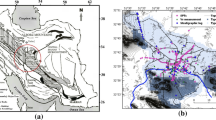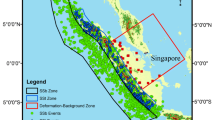Abstract
Some earthquakes in recent years (such as Tangshan earthquake (1976, China), North Ridge earthquake (1994, USA), Kobe earthquake (1995, Japan)) did not occur in known faults; moreover, the detailed data of geology, earthquake, crust deformation, etc. needed by the fault model are very difficult to obtain in many regions of the world. A simplified method of global seismic hazard analysis is developed, based on an area source model and by using seismicity data, and the global seismic hazard map is compiled. To evaluate the effectiveness and credibility of the new method, comparison study of this map with the existing national maps has been performed, which implies that it is considerably valuable to apply this method to practical use.
Similar content being viewed by others
References
Cornell, C. A., Engineering seismic risk analysis,Bull. Seism. Soc. Am., 1968, 58(5):1583.
Kiureghian, A. D., Ang, A. H. S., A fault-rupture model for seismic risk analysis,Bull. Seism. Soc. Am., 1977, 67 (4):1173.
McGuire, R. K., Computation of seismic hazard,Annali di Geophysics, 1993, 36(3–4): 181.
Giardini, D., Basham, P. W., The ILP’s global seismic hazard assessment, Program for UN/IDNDR,Annali di Geophysica, 1993, 36(3-4):257.
Working Group on California Earthquake Probabilities, Probabilities of large earthquakes in the San Francisco bay region, California,Open-File Report 1053-51, US Geol. Survey, 1990.
Gao, M., Poisson-based probability model of seismic intensity occurrence,Earthquake Research in China (in Chinese), 1996, 12(2):195.
Gutenberg, B., Richiter, C. F., Earthquake magnitude, intensity, energy, and acceleration,Bull. Seism. Soc. Am., 1956, 46(2):105.
Hu, Y. X.,Seismic Engineering (in Chinese), Beijing: Seismological Press, 1988, 454.
Chen Ling, Chen Yong, The determination of maximum earthquake magnitude in seismic hazard analysis,Acta Geophyica Sinica (in Chinese), 1998.
Anderson, J. G., On the attenuation of Modified Mercalli Intensity with the distance in the United States,Bull. Seism. Soc. Am., 1978, 68(4):1147.
Howell, B., Schultz, T., Attenuation of Modified Mercalli Intensity with the distance from the epicenter,Bull. Seism. Soc. Am., 1975, 65(3):651.
Gupta, I. N., Nuttli, O. W., Spatial attenuation of intensities for Central U.S. earthquakes,Bull. Seism. Soc. Am., 1976, 66(3):743.
Chamdra, U.et al., Attenuation of Intensities in Iran,Bull. Seism. Soc. Am., 1979, 69(1):237.
Flinn, E. A., Engdahl, E. R., Hill, A. R., Seismic and geographical regionalization,Bull. Seism. Soc. Am., 1974, 64 (3):771.
McGuire, R. K.et al., The practice of earthquake hazard assessment,International Association of Seismology and the Physics of Earth’s Interior, 1993, 2841.
Author information
Authors and Affiliations
About this article
Cite this article
Liu, J., Chen, Y., Chen, L. et al. A simplified approach to the global seismic hazard assessment. Chin.Sci.Bull. 44, 246–251 (1999). https://doi.org/10.1007/BF02896285
Received:
Issue Date:
DOI: https://doi.org/10.1007/BF02896285




